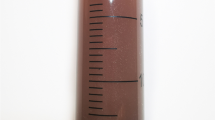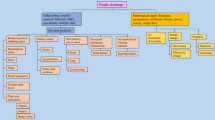Abstract
An understanding of underlying causes of bloody nipple discharge (BND) is necessary to be able to advise treatment guidelines of this rare symptom in the pediatric age group. Of 11 patients with 14 breasts that had BND, data regarding age, sex, side and duration of BND, physical examination findings, laboratory values, culture reports, ultrasonography (US) findings, treatment approach, histopathologic details, and outcomes were obtained, and also, literature was reviewed. The patients were between 3 months and 12 years of age. There were six males and five females. The BND was located in the right breast in six patients, in the left in two, and it was bilateral in three. On physical examinations, seven patients had palpable cystic nodules located at the areolar area and three had a diffuse breast enlargement without skin findings. Laboratory investigations showed normal hormone levels in all patients. At US examinations, seven breasts had cystic lesions, three had hypoechoic tissue in the subareolar region, and others had normal US findings. In a girl with positive culture for Staphylococcus aureus, BND resolved after oral antibiotics. Two cases resolved spontaneously, with 6 months and 4 months follow-up periods, respectively. Surgical intervention was performed for the remaining eight patients, and mean time to operation after onset of symptoms was 10 months (range=1–34 months). Histopathologic findings showed that the underlying cause of BND was duct ectasia in five breasts, gynecomastia in three, and fibrocystic change in two. Their follow-up periods ranged between 3 months and 6 years, and no recurrences were observed. Classification of breasts with BND for selecting appropriate therapy on the basis of results of careful physical examination, with an US evaluation in selected cases, is effective, and prevents unnecessary investigations.



Similar content being viewed by others
References
Vargas HI, Romero L, Chlebowski RT (2002) Management of bloody nipple discharge. Curr Treat Options Oncol 3(2):157–161
Ravitch MM (1979) The breast. In: Ravitch MM, Welch KJ, Benson CD et al (eds) Pediatric surgery. Year Book Medical, Chicago, pp 401–406
Berkowitz CD, Inkelis SH (1983) Bloody nipple discharge in infancy. J Pediatr 103:755–756
Fenster DL (1984) Bloody nipple discharge. J Pediatr 104:640–641
Menken KU, Roll C (1993) Bloody nipple discharge in a 3-year-old girl. Eur J Pediatr 152:1047
Sigalas J (1985) Bloody nipple discharge in infants. J Pediatr 107:484
Gershin T, Mogilner JG (1992) Bloody nipple discharge in an infant (Hebrew with English abstract). Harefuah 122:505–506
Weinmann E (2003) Clinical management of nipple discharge in neonates and children. J Paediatr Child Health 39:155–156
Stringel G, Perelman A, Jimenez C (1986) Infantile mammary duct ectasia: a cause of bloody nipple discharge. J Pediatr Surg 21:671–674
West KW, Rescorla FJ, Schere III LR et al (1995) Diagnosis and treatment of symptomatic breast masses in the pediatric population. J Pediatr Surg 30:182–187
Böber E, Özer E, Akgür F et al (1996) Bilateral breast masses and bloody nipple discharge in a two year-old boy. J Pediatr Endocrinol Metab 9:419–421
Kitahara S, Wakabayashi M, Shiba T et al (2001) Mammary duct ectasia in children presenting bloody nipple discharge: a case in a pubertal girl. J Pediatr Surg 36:E2
Miller JD, Brownell MD, Shaw A (1990) Bilateral breast masses and bloody nipple discharge in a 4-year-old boy. J Pediatr 116:744–747
Olcay I, Gököz A (1992) Infantile gynecomastia with bloody nipple discharge. J Pediatr Surg 27:103–104
Simpson JS, Barson AJ (1969) Breast tumors in infants and children. Can Med Assoc J 101:100–102
Küçükaydın M, Ökten T, Okur H et al (1987) Intraductal papilloma in children (Turkish with English abstract). J Erciyes Univ Med Fac 9:547–550
Martino A, Zamparelli M, Santinelli A et al (2001) Unusual clinical presentation of a rare case of Phyllodes tumor of the breast in an adolescent girl. J Pediatr Surg 36:941–943
Diaconu C, Socolov D, Dragomir C, Costachescu N Florea (1996) Periductal mastitis and mammary duct ectasia: two stages of the same disease? Eur J Cancer 32 (Suppl 1):S19
Tanabe K (1996) Duct ectasia, periductal mastitis, and infections. In: Harris JR, Lippman ME, Morrow M, Hellman S (eds) Diseases of the breast. Lippincott-Raven, Philadelphia, pp 49–53
Greydanus DE, Parks DS, Farrell EG (1989) Breast disorders in children and adolescent. Pediatr Clin North Am 36:601–638
Author information
Authors and Affiliations
Corresponding author
Rights and permissions
About this article
Cite this article
İmamoglu, M., Çay, A., Reis, A. et al. Bloody nipple discharge in children: possible etiologies and selection of appropriate therapy. Ped Surgery Int 22, 158–163 (2006). https://doi.org/10.1007/s00383-005-1559-6
Accepted:
Published:
Issue Date:
DOI: https://doi.org/10.1007/s00383-005-1559-6




